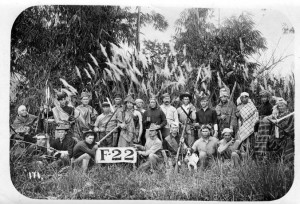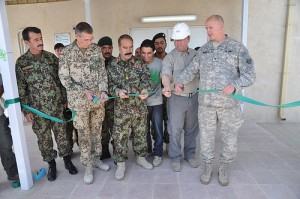President Obama has made a popular promise – to bring American troops home from Afghanistan by the end of 2014. But this exit strategy does not really apply to all U.S. forces, because the plan is to leave behind a large force of private contractors and military advisers. They are supposed to help professionalize Afghanistan’s internal security and police forces, promote stability, and aid in democratic development.
Historically, however, police training programs run by the United States have not achieved such lofty objectives. They have often ended up hindering democratic development and furthering the growth of draconian apparatuses of surveillance and repressive social control. U.S. contractors and advisors have too often propped up coercive client regimes, breeding popular backlash. The same story could well be unfolding once again in Afghanistan. To date, the United States has pumped in over $10 billion to the Afghan police, whose leaders are notorious for corruption and the commission of extralegal abuses. Spending an additional billion for police training, as the Obama administration plans, could end up increasing corruption and repression and intensifying sectarian divisions that make it difficult for Afghanistan to function as a stable democracy.
The Repressive Consequences of Police Training

From the conquest of the Philippines and Haiti around 1900, through Cold War interventions and the War on Terror in more recent times, U.S. policymakers have seen police training as a cost-effective means of suppressing challengers to friendly regimes – while at the same time reducing the need for direct U.S. military intervention or allowing a drawdown of troops from an earlier intervention. But abuses have regularly ensued:
- In 1901, following protests by the anti-imperialist league over atrocities committed by American soldiers, the Roosevelt administration developed a Filipino constabulary which used a mixture of covert penetration and violence to gradually subdue remnants of the nationalist resistance. The constabulary endured and came to be seen as a model by American officials. Yet it also contributed to a legacy of political authoritarianism in the Philippines.
- In Japan after its defeat in World War II, American advisers trained local police in riot control and clandestine surveillance. Initially, the Supreme Command of the Allied Powers aimed to purge ultranationalist elements and promote civil liberties in Occupied Japan. But with the onset of the Cold War, the Truman administration became committed to retaining American military bases in Japan, and U.S.-supported policing methods became more focused on suppressing the Japanese Communist Party and undercutting challenges to the labor movement.
- Building from the Japanese precedent, the Eisenhower administration established a foreign aid program to “aid in the detection of communists and fellow travelers” and “suppress local dissidence before military-type action was necessary.” Subsequently, the Kennedy administration followed suit by establishing the Office of Public Safety under the United States Agency for International Development, which supplied half a billion dollars of equipment, advisers and training to foreign police forces. Hundreds were brought each year to the International Police Academy in Washington DC, where they received instruction in police administration, counterinsurgency and anticommunist ideology, with little attention to rudimentary standards of criminal justice and civil rights. As Charles Maechling, Jr., a counterinsurgency staff director, would later explain, “the United States provided regimes having only a façade of constitutional safeguards with updated law enforcement machinery readily adaptable to political intimidation and state terrorism. Record keeping in particular was immediately put to use in tracking down student radicals and union organizers.”
Before it was abolished by Congress in 1974, the Office of Public Safety ran the prison system in South Vietnam, which became notorious for torture and imprisoning suspected Communists in six foot windowless “tiger cages” where they were fed starvation diets. According to Time Magazine, survivors resembled “grotesque sculptures of scarred flesh and gnarled limbs… They move like crabs skittering across the floor on buttocks and palm.”
The Dangers of Subcontracting in Afghanistan

Ignoring this history, Western policymakers have championed police programs in Afghanistan as a cost-effective means of stabilizing Hamid Karzai’s government. Much police training in Afghanistan is now subcontracted to private companies – most notably to DynCorp International, whose employees are paid six figure salaries and subjected to only minimal public oversight. Western private contractors have alienated the native population with practices such as reckless driving, public drunkenness, and shooting civilians. They work hand in glove with the Afghan National Police, an organization often known for abuses that include routinely shaking down civilians, shooting demonstrators, terrorizing people in raids, and intimidating voters during obviously rigged elections.
In 2006, the Kabul Chief of Police, Jamil Jumbish, was implicated in murder, torture and bribery – and his replacement has been little better, known for extortion, land grabbing and even kidnapping three United Nations workers. Such abuses are longstanding in Afghanistan, but they have been exacerbated by the military interventions led by the United States and its European allies and by the accompanying mobilization of police for military tasks.
In short, Americans should greet with skepticism claims that police training by U.S. advisors and contractors will further democratic development in Afghanistan. Perhaps many U.S. authorities actually want to retain a client regime and military bases in Central Asia, in order to preserve American leverage in the unfolding competition with China and Russia. Whatever the true aims, however, the United States may end up providing long-term, expensive assistance to an unstable and repressive client government, whose abuses could well spark determined and sustained resistance from many Afghans. Indeed, continuing U.S. military and police assistance could end up driving many Afghans back into the hands of the Taliban – the very radical Islamic fundamentalists the West originally intervened to defeat after September 2011. Afghans could end up returning to the Taliban allegiance if they see Islamicists as the only available indigenous alternative to a brutal, mafia-like regime installed by foreign advisors. It would hardly be in the true interest of the United States to further such an outcome.

 Research to Improve Policy: The Scholars Strategy Network seeks to improve public policy and strengthen democracy by organizing scholars working in America's colleges and universities. SSN's founding director is Theda Skocpol, Victor S. Thomas Professor of Government and Sociology at Harvard University.
Research to Improve Policy: The Scholars Strategy Network seeks to improve public policy and strengthen democracy by organizing scholars working in America's colleges and universities. SSN's founding director is Theda Skocpol, Victor S. Thomas Professor of Government and Sociology at Harvard University.